Dukkha
Main articles: Dukkha and Four Noble Truths
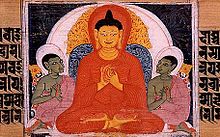
The Buddha teaching the Four Noble Truths.
Sanskrit manuscript.
Nalanda, Bihar, India.
The Four Truths express the basic orientation of Buddhism: we crave and cling to impermanent states and things, which is dukkha,[51] "incapable of satisfying"[web 2] and painful.[47][48] This keeps us caught in saṃsāra, the endless cycle of repeated rebirth, dukkha and dying again.[note 8] But there is a way to liberation from this endless cycle[57] to the state of nirvana, namely following the Noble Eightfold Path. [note 9]
The truth of dukkha is the basic insight that life in this "mundane world," with its clinging and craving to impermanent states and things"[47] is dukkha, and unsatisfactory.[52][64][web 3] We expect happiness from states and things which are impermanent, and therefore cannot attain real happiness.
Dukkha arises when we crave (Pali: tanha) and cling to these changing phenomena. The clinging and craving produces karma, which ties us to samsara, the round of death and rebirth.[69][web 7][note 10] Craving includes kama-tanha, craving for sense-pleasures; bhava-tanha, craving to continue the cycle of life and death, including rebirth; and vibhava-tanha, craving to not experience the world and painful feelings.[69][70][71]
Dukkha ceases, or can be confined,[72] when craving and clinging cease or are confined. This also means that no more karma is being produced, and rebirth ends.[note 11] Cessation is nirvana, "blowing out," and peace of mind.[74][75][76]
By following the Buddhist path to moksha, liberation,[59] one starts to disengage from craving and clinging to impermanent states and things. The term "path" is usually taken to mean the Noble Eightfold Path, but other versions of "the path" can also be found in the Nikayas.[77] The Theravada tradition regards insight into the four truths as liberating in itself.[66]
In Buddhism, dukkha is one of the three marks of existence, along with impermanence and anattā (non-self).[78] Buddhism, like other major Indian religions, asserts that everything is impermanent (anicca), but, unlike them, also asserts that there is no permanent self or soul in living beings (anattā).[79][80][81] The ignorance or misperception (avijjā) that anything is permanent or that there is self in any being is considered a wrong understanding, and the primary source of clinging and dukkha.[82][83][84]
Rebirth
Saṃsāra
Main article: Saṃsāra (Buddhism)
Saṃsāra means "wandering" or "world", with the connotation of cyclic, circuitous change.[85][86]
It refers to the theory of rebirth and "cyclicality of all life,
matter, existence", a fundamental assumption of Buddhism, as with all
major Indian religions.[86][87] Samsara in Buddhism is considered to be dukkha, unsatisfactory and painful,[88] perpetuated by desire and avidya (ignorance), and the resulting karma.[86][89][90]The theory of rebirths, and realms in which these rebirths can occur, is extensively developed in Buddhism, in particular Tibetan Buddhism with its wheel of existence (Bhavacakra) doctrine.[88] Liberation from this cycle of existence, Nirvana, has been the foundation and the most important historical justification of Buddhism.[91][92]
The later Buddhist texts assert that rebirth can occur in six realms of existence, namely three good realms (heavenly, demi-god, human) and three evil realms (animal, hungry ghosts, hellish).[note 12] Samsara ends if a person attains nirvana, the "blowing out" of the desires and the gaining of true insight into impermanence and non-self reality.[94][95][96]
Rebirth
Main article: Rebirth (Buddhism)
Rebirth refers to a process whereby beings go through a succession of lifetimes as one of many possible forms of sentient life, each running from conception to death.[97] In Buddhist thought, this rebirth does not involve any soul, because of its doctrine of anattā (Sanskrit: anātman, no-self doctrine) which rejects the concepts of a permanent self or an unchanging, eternal soul, as it is called in Hinduism and Christianity.[98] According to Buddhism there ultimately is no such thing as a self in any being or any essence in any thing.[99]The Buddhist traditions have traditionally disagreed on what it is in a person that is reborn, as well as how quickly the rebirth occurs after each death.[100][101] Some Buddhist traditions assert that "no self" doctrine means that there is no perduring self, but there is avacya (inexpressible) self which migrates from one life to another.[100] The majority of Buddhist traditions, in contrast, assert that vijñāna (a person's consciousness) though evolving, exists as a continuum and is the mechanistic basis of what undergoes rebirth, rebecoming and redeath.[52][100] The rebirth depends on the merit or demerit gained by one's karma, as well as those accrued on one's behalf by a family member.[note 13]
Each rebirth takes place within one of five realms according to Theravadins, or six according to other schools – heavenly, demi-gods, humans, animals, hungry ghosts and hellish.[103][104][note 14]
In East Asian and Tibetan Buddhism, rebirth is not instantaneous, and there is an intermediate state (Tibetan "bardo") between one life and the next.[114][115] The orthodox Theravada position rejects the wait, and asserts that rebirth of a being is immediate.[114] However there are passages in the Samyutta Nikaya of the Pali Canon that seem to lend support to the idea that the Buddha taught of an intermediate stage between one life and the next.[116][117][page needed]
Karma
Main article: Karma in Buddhism
In Buddhism, Karma (from Sanskrit: "action, work") drives saṃsāra—the
endless cycle of suffering and rebirth for each being. Good, skilful
deeds (Pali: "kusala") and bad, unskilful deed (Pāli: "akusala") produce
"seeds" in the unconscious receptacle (ālaya) that mature later either in this life or in a subsequent rebirth.[118][119]
The existence of Karma is a core belief in Buddhism, as with all major
Indian religions, it implies neither fatalism nor that everything that
happens to a person is caused by Karma.[120][note 15]A central aspect of Buddhist theory of karma is that intent (cetanā) matters and is essential to bring about a consequence or phala "fruit" or vipāka "result".[121][note 16] However, good or bad karma accumulates even if there is no physical action, and just having ill or good thoughts create karmic seeds; thus, actions of body, speech or mind all lead to karmic seeds.[120] In the Buddhist traditions, life aspects affected by the law of karma in past and current births of a being include form of rebirth, realm of rebirth, social class, character and major circumstances of a lifetime.[120][125][126] It operates like the laws of physics, without external intervention, on every being in all six realms of existence including human beings and gods.[120][127]
A notable aspect of the karma theory in Buddhism is merit transfer.[128][129] A person accumulates merit not only through intentions and ethical living, but also is able to gain merit from others by exchanging goods and services, such as through dāna (charity to monks or nuns).[130] Further, a person can transfer one's own good karma to living family members and ancestors.[129][note 17]
Liberation
Mahabodhi Temple in Bodh Gaya, India, where Gautama Buddha attained nirvana under the Bodhi Tree (left)
Main articles: Moksha and Nirvana (Buddhism)
Nirvana (nibbāna) has been the primary and the soteriological goal of the Buddhist path for monastic life, since the time of the Buddha.[59][133][134] The term "path" is usually taken to mean the Noble Eightfold Path, but other versions of "the path" can also be found in the Nikayas.[note 18]
For example, in some Pali Canons, the Buddha explains that the
cultivation of the noble eightfold path by a learner monk leads to the
development of two further paths of the Arhats, which are right knowledge or insight (sammā-ñāṇa), and right liberation or release (sammā-vimutti).[135][136]Nirvana literally means "blowing out, quenching, becoming extinguished".[137][138] In early Buddhist texts, it is the state of restraint and self-control that leads to the "blowing out" and the ending of the cycles of sufferings associated with rebirths and redeaths.[139][140][141] Many later Buddhist texts describe nirvana as identical with Anatta with complete "Emptiness, Nothingness".[142][143][144][note 19] In some texts, the state is described with greater detail, such as passing through the gate of Emptiness (sunyata) – realizing that there is no soul or self in any living being, then passing through the gate of signlessness (animitta) – realizing that nirvana cannot be perceived, and finally passing through the gate of wishlessness (apranihita) – realizing that nirvana is the state of not even wishing for nirvana.[133][146][note 20]
The nirvana state has been described in Buddhist texts partly in a manner similar to other Indian religions, as the state of complete liberation, enlightenment, highest happiness, bliss, fearlessness, freedom, permanence, non-dependent origination, unfathomable, indescribable.[148][149] It has also been described in part differently, as a state of spiritual release marked by "emptiness" and realization of non-Self.[150][151][152][note 21]
While Buddhism considers the liberation from Saṃsāra as the ultimate spiritual goal, in traditional practice, the primary focus of a vast majority of lay Buddhists has been to seek and accumulate merit through good deeds, donations to monks and various Buddhist rituals in order to gain better rebirths rather than nirvana.[155][109][note 22]
Bhavana (practice, cultivation)
Basic practices include sila (ethics), samadhi (meditation, dhyana) and prajna (wisdom), as described in the Noble Eightfold Path. An important additional practice is a kind and compassionate attitude toward every living being and the world. Devotion is also important in some Buddhist traditions, and in the Tibetan traditions visualizations of deities and mandalas are important. The value of textual study is regarded differently in the various Buddhist traditions. It is central to Theravada and highly important to Tibetan Buddhism, while the Zen tradition takes an ambiguous stance.The Buddhist path
While the Noble Eightfold Path is best-known in the west, a wide variety of practices and stages have been used and described in the Buddhist traditions. Even in the Theravada canon, the Pali-suttas, various often irreconcilable sequences can be found. According to Carol Anderson, the Theravada-canon lacks "an overriding and comprehensive structure of the path to nibbana."[156]Middle Way
Main article: Middle Way
An important guiding principle of Buddhist practice is the Middle Way (madhyamapratipad). It was a part of Buddha's first sermon, where he presented the Noble Eightfold Path that was a 'middle way' between the extremes of asceticism and hedonistic sense pleasures.[157][158] In Buddhism, states Harvey, the doctrine of "dependent arising" (conditioned arising, pratītyasamutpāda)
to explain rebirth is viewed as the 'middle way' between the doctrines
that a being has a "permanent soul" involved in rebirth (eternalism) and
"death is final and there is no rebirth" (annihilationism).[159][160]Theravada
The Dharmachakra represents the Noble Eightfold Path
Noble Eightfold Path
Main articles: Noble Eightfold Path and Buddhist Paths to liberation
The Noble Eightfold Path,
or "Eightfold Path of the Noble Ones", consists of a set of eight
interconnected factors or conditions, that when developed together, lead
to the cessation of dukkha.[161]
These eight factors are: Right View (or Right Understanding), Right
Intention (or Right Thought), Right Speech, Right Action, Right
Livelihood, Right Effort, Right Mindfulness, and Right Concentration.This Eightfold Path is the fourth of the Buddha's Four Noble Truths, and asserts the path to the cessation of dukkha (suffering, pain, unsatisfactoriness).[162][163] The path teaches that the way of the enlightened ones stopped their craving, clinging and karmic accumulations, and thus ended their endless cycles of rebirth and suffering.[164][165][166]
The Noble Eightfold Path is grouped into three basic divisions, as follows:[167][168][169]
| Division | Eightfold factor | Sanskrit, Pali | Description |
|---|---|---|---|
| Wisdom (Sanskrit: prajñā, Pāli: paññā) |
1. Right view | samyag dṛṣṭi, sammā ditthi |
the belief that there is an afterlife and not everything ends with death, that Buddha taught and followed a successful path to nirvana;[167] According to Peter Harvey, the right view is held in Buddhism as a belief in the Buddhist principles of karma and rebirth, and the importance of the Four Noble Truths and the True Realities.[170] |
| 2. Right intention | samyag saṃkalpa, sammā saṅkappa |
the giving up home and adopting the life of a religious mendicant in order to follow the path;[167] this concept, states Harvey, aims at peaceful renunciation, into an environment of non-sensuality, non-ill-will (to lovingkindness), away from cruelty (to compassion).[170] | |
| Moral virtues[168] (Sanskrit: śīla, Pāli: sīla) |
3. Right speech | samyag vāc, sammā vāca |
no lying, no rude speech, no telling one person what another says about him, speaking that which leads to salvation;[167] |
| 4. Right action | samyag karman, sammā kammanta |
no killing or injurying, no taking what is not given; no sexual acts in monastic pursuit,[167] for lay Buddhists no sensual misconduct such as sexual involvement with someone married, or with an unmarried woman protected by her parents or relatives.[171][172][173] | |
| 5. Right livelihood | samyag ājīvana, sammā ājīva |
For monks, beg to feed, only possessing what is essential to sustain life.[174] For lay Buddhists, the canonical texts state right livelihood as abstaining from wrong livelihood, explained as not becoming a source or means of suffering to sentient beings by cheating them, or harming or killing them in any way.[175][176] | |
| Meditation[168] (Sanskrit and Pāli: samādhi) |
6. Right effort | samyag vyāyāma, sammā vāyāma |
guard against sensual thoughts; this concept, states Harvey, aims at preventing unwholesome states that disrupt meditation.[177] |
| 7. Right mindfulness | samyag smṛti, sammā sati |
never be absent minded, conscious of what one is doing; this, states Harvey, encourages the mindfulness about impermanence of body, feeling and mind, as well as to experience the five skandhas, the five hindrances, the four True Realities and seven factors of awakening.[177] | |
| 8. Right concentration | samyag samādhi, sammā samādhi |
Correct meditation or concentration, explained as the four jhānas.[167][178] |
Mahayana
Six paramitas
In the earliest texts of Mahayana Buddhism, the path of a bodhisattva was to awaken the bodhicitta.[185] Between 1st and 3rd century CE, this tradition introduced the Ten Bhumi doctrine, which means ten levels or stages of awakening.[185] This development was followed by the acceptance that it is impossible to achieve Buddhahood in one (current) lifetime, and the best goal is not nirvana for oneself, but Buddhahood after climbing through the ten levels during multiple rebirths.[186] Mahayana scholars then outlined an elaborate path, for monks and laypeople, and the path includes the vow to help teach Buddhist knowledge to other beings, so as to help them cross samsara and liberate themselves, once one reaches the Buddhahood in a future rebirth.[180] One part of this path are the Pāramitā (perfections, to cross over), derived from the Jatakas tales of Buddha's numerous rebirths.[187][188]
The Mahayana texts are inconsistent in their discussion of the Paramitas, and some texts include lists of two, others four, six, ten and fifty two.[189][190][191] The six paramitas have been most studied, and these are:[187][191][192]
- Dāna pāramitā: perfection of giving; primarily to monks, nuns and the Buddhist monastic establishment dependent on the alms and gifts of the lay householders, in return for generating religious merit;[193] some texts recommend ritually transferring the merit so accumulated for better rebirth to someone else
- Śīla pāramitā : perfection of morality; it outlines ethical behaviour for both the laity and the Mahayana monastic community; this list is similar to Śīla in the Eightfold Path (i.e. Right Speech, Right Action, Right Livelihood)[194]
- Kṣānti pāramitā : perfection of patience, willingness to endure hardship
- Vīrya pāramitā : perfection of vigour; this is similar to Right Effort in the Eightfold Path[194]
- Dhyāna pāramitā : perfection of meditation; this is similar to Right Concentration in the Eightfold Path
- Prajñā pāramitā : perfection of insight (wisdom), awakening to the characteristics of existence such as karma, rebirths, impermanence, no-self, dependent origination and emptiness;[191][195] this is complete acceptance of the Buddha teaching, then conviction, followed by ultimate realization that "dharmas are non-arising".[187]
Refuge in the Three Jewels
Main articles: Refuge (Buddhism) and Three Jewels
Traditionally, the first step in most Buddhist schools requires taking Three Refuges, also called the Three Jewels (Sanskrit: triratna, Pali: tiratana) as the foundation of one's religious practice.[198] Pali texts employ the Brahmanical motif of the triple refuge, found in the Rigveda 9.97.47, Rigveda 6.46.9 and Chandogya Upanishad 2.22.3–4.[199] Tibetan Buddhism sometimes adds a fourth refuge, in the lama. The three refuges are believed by Buddhists to be protective and a form of reverence.[198]The Three Jewels are:[200]
- The Buddha, the Gotama, the Blessed One, the Awakened with true knowledge
- The Dharma, the precepts, the practice, the Four Truths, the Eightfold Path
- The Sangha, order of monks, the community of Buddha's disciples
Śīla – Buddhist ethics
Main article: Buddhist ethics
Śīla appear as ethical precepts for both lay and ordained Buddhist devotees. It includes the Five Precepts for laypeople, Eight or Ten Precepts for monastic life, as well as rules of Dhamma (Vinaya or Patimokkha) adopted by a monastery.[201][202]
Precepts
The five precepts (panca-sila) are moral behavioural and ritual guidelines for lay devotee in Buddhism, while those following a monastic life have rules of conduct (patimokkha).[203] The five precepts apply to both male and female devotee, and these are:[201][204]- Abstain from killing (Ahimsa);
- Abstain from stealing;
- Abstain from sensual (including sexual) misconduct;
- Abstain from lying;
- Abstain from intoxicants.
The monastic life in Buddhism have additional precepts as part of patimokkha, and unlike lay people, transgressions by monks do invite sanctions.[207] Full expulsion from sangha follows any instance of killing, engaging in sexual intercourse, theft or false claims about one's knowledge.[207] Temporary expulsion follows a lesser offence.[207] The sanctions vary by the monastic fraternity (nikaya).[208]
The precepts for monks in many Buddhist fraternities are eight (asta shila) or ten (das shila). Four of these are same as for the lay devotee: no killing, no stealing, no lying, and no intoxicants.[209] The other four precepts are:[210][209][note 23]
- No sexual activity;
- Abstain from eating at wrong time (e.g. only eat solid food before 12 noon);
- Abstain from jewelry, perfume, adornment, entertainment;
- Abstain from sleeping on high beds;[note 24]
Vinaya
Monks performing a ceremony in Hangzhou, China
Monastic communities in the Buddhist tradition, cut normal social ties to family and community, and live as "islands unto themselves".[215] Within a monastic fraternity, a sangha has its own rules.[215] A monk abides by these institutionalized rules, and living life as the vinaya prescribes it is not merely a means, but very nearly the end in itself.[215] Transgressions by a monk on Sangha vinaya rules invites enforcement, which can include temporary or permanent expulsion.[216]
Meditation and insight
See also: Yoga
The Buddhist tradition has incorporated two traditions regarding the use of dhyāna (meditation, Pali jhāna).[217] There is a tradition that stresses attaining prajñā (insight, bodhi, kenshō, vipassana) as the means to awakening and liberation. But it has also incorporated the yogic tradition, as reflected in the use of jhana, which is rejected in other sutras as not resulting in the final result of liberation.[139][217][218][note 26] Schmithausen discerns three possible roads to liberation as described in the suttas,[220] to which Vetter adds the sole practice of dhyana itself, which he sees as the original "liberating practice":[221][note 27]- The four Rupa Jhanas themselves constituted the core liberating practice of early buddhism, c.q. the Buddha;[221][note 27]
- Mastering the four Rupa Jhanas, where-after "liberating insight" is attained;
- Mastering the four Rupa Jhanas and the four Arupa Jhanas, where-after "liberating insight" is attained;
- Liberating insight itself suffices.
Dhyana – meditation
Bhikkhus in Thailand
Origins
The earliest evidence of yogis and their meditative tradition, states Karel Werner, is found in the Keśin hymn 10.136 of the Rigveda.[224] While evidence suggests meditation was practiced in the centuries preceding the Buddha,[225] the meditative methodologies described in the Buddhist texts are some of the earliest among texts that have survived into the modern era.[226][227] These methodologies likely incorporate what existed before the Buddha as well as those first developed within Buddhism.[228][note 29]According to Bronkhorst, the Four Dhyanas was a Buddhist invention.[232] Bronkhorst notes that the Buddhist canon has a mass of contradictory statements, little is known about their relative chronology, and "there can be no doubt that the canon – including the older parts, the Sutra and Vinaya Pitaka – was composed over a long period of time".[233] Meditative practices were incorporated from other sramanic movements;[217] the Buddhist texts describe Buddha learnt the practice of the formless dhyana from Brahmanical practices, in the Nikayas ascribed to Alara Kalama and Uddaka Ramaputta.[234][235] The Buddhist canon also describes and criticizes alternative dhyana practices, which likely mean the pre-existing mainstream meditation practices of Jainism and Hinduism.[236]
Buddha added a new focus and interpretation, particularly through the Four Dhyanas methodology,[237] in which mindfulness is maintained.[238][222] Further, the focus of meditation and the underlying theory of liberation guiding the meditation has been different in Buddhism.[225][239][240] For example, states Bronkhorst, the verse 4.4.23 of the Brihadaranyaka Upanishad with its "become calm, subdued, quiet, patiently enduring, concentrated, one sees soul in oneself" is most probably a meditative state.[241] The Buddhist discussion of meditation is without the concept of soul and the discussion criticizes both the ascetic meditation of Jainism and the "real self, soul" meditation of Hinduism.[242]
Four rupa-jhāna and four arupa-jhāna
For Nirvana, Buddhist texts teach various meditation methodologies, of which rupa-jhana (four meditations in the realm of form) and arupa-jhana (four meditations in the formless realm) have been the most studied.[243] These are described in the Pali Canon as trance-like states in the world of desirelessness.[244] The four dhyanas under rupa-jhanas are:[244]- First dhyana: detach from all sensory desires and sinful states that are a source of unwholesome karma. Success here is described in Buddhist texts as leading to discursive thinking, deliberation, detachment, sukha (pleasure) and priti (rapture).[243][note 30]
- Second dhyana: cease deliberation and all discursive thoughts.[244] Success leads to one-pointed thinking, serenity, pleasure and rapture.[243]
- Third dhyana: lose feeling of rapture. Success leads to equanimity, mindfulness and pleasure, without rapture.[243]
- Fourth dhyana: cease all effects, lose all happiness and sadness. Success in the fourth meditation stage leads to pure equanimity and mindfulness, without any pleasure or pain.[243][244]
Richard Gombrich notes that the sequence of the four rupa-jhanas describes two different cognitive states. The first two describe a narrowing of attention, while in the third and fourth jhana attention is expanded again.[248][note 31][249] Alexander Wynne further explains that the dhyana-scheme is poorly understood.[250] According to Wynne, words expressing the inculcation of awareness, such as sati, sampajāno, and upekkhā, are mistranslated or understood as particular factors of meditative states,[250] whereas they refer to a particular way of perceiving the sense objects.[250][note 32][note 33]
The Brahma-vihara
Statue of Buddha in Wat Phra Si Rattana Mahathat, Phitsanulok, Thailand
Main article: Brahmavihara
The four immeasurables or four abodes, also called Brahma-viharas,
are virtues or directions for meditation in Buddhist traditions, which
helps a person be reborn in the heavenly (Brahma) realm.[252][253][254] These are traditionally believed to be a characteristic of the deity Brahma and the heavenly abode he resides in.[255]The four Brahma-vihara are:
- Loving-kindness (Pāli: mettā, Sanskrit: maitrī) is active good will towards all;[253][256]
- Compassion (Pāli and Sanskrit: karuṇā) results from metta, it is identifying the suffering of others as one's own;[253][256]
- Empathetic joy (Pāli and Sanskrit: muditā): is the feeling of joy because others are happy, even if one did not contribute to it, it is a form of sympathetic joy;[256]
- Equanimity (Pāli: upekkhā, Sanskrit: upekṣā): is even-mindedness and serenity, treating everyone impartially.[253][256]
According to Gombrich, the Buddhist usage of the brahma-vihāra originally referred to an awakened state of mind, and a concrete attitude toward other beings which was equal to "living with Brahman" here and now. The later tradition took those descriptions too literal, linking them to cosmology and understanding them as "living with Brahman" by rebirth in the Brahma-world.[263] According to Gombrich, "the Buddha taught that kindness – what Christians tend to call love – was a way to salvation.[264]
Visualizations: deities, mandalas
Mandala are used in Buddhism for initiation ceremonies and visualization.[265]
In Tibetan Buddhism tradition, mandala are mystical maps for the visualization process with cosmic symbolism.[265] There are numerous deities, each with a mandala, and they are used during initiation ceremonies and meditation.[265] The mandalas are concentric geometric shapes symbolizing layers of external world, gates and sacred space. The meditation deity is in the centre, sometimes surrounded by protective gods and goddesses.[265] Visualizations with deities and mandalas in Buddhism is a tradition traceable to ancient times, and likely well established by the time the 5th-century text Visuddhimagga was composed.[265][269]
Practice: monks, laity
According to Peter Harvey, whenever Buddhism has been healthy, not only ordained but also more committed lay people have practiced formal meditation.[270] Loud devotional chanting however, adds Harvey, has been the most prevalent Buddhist practice and considered a form of meditation that produces "energy, joy, lovingkindness and calm", purifies mind and benefits the chanter.[271]Throughout most of Buddhist history, meditation has been primarily practiced in Buddhist monastic tradition, and historical evidence suggests that serious meditation by lay people has been an exception.[272][273][274] In recent history, sustained meditation has been pursued by a minority of monks in Buddhist monasteries.[275] Western interest in meditation has led to a revival where ancient Buddhist ideas and precepts are adapted to Western mores and interpreted liberally, presenting Buddhism as a meditation-based form of spirituality.[275]
Prajñā – insight
Monks debating at Sera Monastery, Tibet
Origins
The origins of "liberating insight" is unclear. Buddhist texts, states Bronkhorst, do not describe it explicitly, and the content of "liberating insight" is likely not original to Buddhism and was "added under the influence of mainstream meditation".[282]Bronkhorst suggests that the conception of what exactly constituted "liberating insight" for Buddhists developed over time. Whereas originally it may not have been specified as an insight, later on the Four Noble Truths served as such, to be superseded by pratityasamutpada, and still later, in the Hinayana schools, by the doctrine of the non-existence of a substantial self or person.[283]
Other descriptions of this "liberating insight" exist in the Buddhist canon: that the five Skandhas are impermanent, disagreeable, and neither the Self nor belonging to oneself"; "the contemplation of the arising and disappearance (udayabbaya) of the five Skandhas"; "the realisation of the Skandhas as empty (rittaka), vain (tucchaka) and without any pith or substance (asaraka).In the Pali Canon liberating insight is attained in the fourth dhyana.[285] However, states Vetter, modern scholarship on the Pali Canon has uncovered a "whole series of inconsistencies in the transmission of the Buddha's word", and there are many conflicting versions of what constitutes higher knowledge and samadhi that leads to the liberation from rebirth and suffering.[286] Even within the Four Dhyana methodology of meditation, Vetter notes that "penetrating abstract truths and penetrating them successively does not seem possible in a state of mind which is without contemplation and reflection."[287] According to Vetter, dhyāna itself constituted the original "liberating practice".[221][note 27]
— Lambert Schmithausen, [284]
Carol Anderson notes that insight is often depicted in the Vinaya as the opening of the Dhamma eye, which sets one on the Buddhist path to liberation.[288]
Theravada
Vipassanā
Main article: Vipassanā
In Theravada Buddhism, but also in Tibetan Buddhism, two types of meditation Buddhist practices are being followed, namely samatha (Pāli; Sanskrit: śamatha; "calm") and vipassana (insight).[289][290] Samatha is also called "calming meditation", and was adopted into Buddhism from pre-Buddha Indian traditions. Vipassanā
meditation was added by Buddha, and refers to "insight meditation".
Vipassana does not aim at peace and tranquillity, states Damien Keown,
but "the generation of penetrating and critical insight (panna)".[291]The focus of Vipassana meditation is to continuously and thoroughly know impermanence of everything (annica), no-Self in anything (anatta) and dukkha teachings of Buddhism.[292][293]
Contemporary Theravada orthodoxy regards samatha as a preparation for vipassanā, pacifying the mind and strengthening the concentration in order to allow the work of insight, which leads to liberation. In contrast, the Vipassana Movement argues that insight levels can be discerned without the need for developing samatha further due to the risks of going out of course when strong samatha is developed.[294]
Dependent arising
Main articles: Pratītyasamutpāda and Twelve Nidānas
Pratityasamutpada, also called "dependent arising, or
dependent origination", is the Buddhist theory to explain the nature and
relations of being, becoming, existence and ultimate reality. Buddhism
asserts that there is nothing independent, except the state of nirvana.[295]
All physical and mental states depend on and arise from other
pre-existing states, and in turn from them arise other dependent states
while they cease.[296]The 'dependent arisings' have a causal conditioning, and thus Pratityasamutpada is the Buddhist belief that causality is the basis of ontology, not a creator God nor the ontological Vedic concept called universal Self (Brahman) nor any other 'transcendent creative principle'.[297][298] However, the Buddhist thought does not understand causality in terms of Newtonian mechanics, rather it understands it as conditioned arising.[299][300] In Buddhism, dependent arising is referring to conditions created by a plurality of causes that necessarily co-originate a phenomenon within and across lifetimes, such as karma in one life creating conditions that lead to rebirth in one of realms of existence for another lifetime.[301][302][303]
Buddhism applies the dependent arising theory to explain origination of endless cycles of dukkha and rebirth, through its Twelve Nidānas or "twelve links" doctrine. It states that because Avidyā (ignorance) exists Saṃskāras (karmic formations) exists, because Saṃskāras exists therefore Vijñāna (consciousness) exists, and in a similar manner it links Nāmarūpa (sentient body), Ṣaḍāyatana (six senses), Sparśa (sensory stimulation), Vedanā (feeling), Taṇhā (craving), Upādāna (grasping), Bhava (becoming), Jāti (birth), Jarāmaraṇa (old age, death, sorrow, pain).[304][305]
By breaking the circuitous links of Twelve Nidanas, Buddhism asserts that a liberation from this endless cycles of rebirth and dukkha can be attained.[306]
Mahayana
Emptiness
Main articles: Śūnyatā and Madhyamaka
Śūnyatā, or "emptiness", is a central concept in Nagarjuna's Madhyamaka school, and widely attested in the Prajñāpāramitā sutras. It brings together key Buddhist doctrines, particularly anatta and dependent origination, to refute the metaphysics of Sarvastivada and Sautrāntika (extinct non-Mahayana schools). Not only sentient beings are empty of ātman; all phenomena (dharmas) are without any svabhava
(literally "own-nature" or "self-nature"), and thus without any
underlying essence, and "empty" of being independent; thus the heterodox
theories of svabhava circulating at the time were refuted on the basis
of the doctrines of early Buddhism.[307]Mind-only
Main articles: Yogachara and Laṅkāvatāra Sūtra
Sarvastivada teachings, which were criticized by Nāgārjuna, —were reformulated by scholars such as Vasubandhu and Asanga and were adapted into the Yogachara
school. While the Mādhyamaka school held that asserting the existence
or non-existence of any ultimately real thing was inappropriate, some
exponents of Yogachara asserted that the mind and only the mind is
ultimately real (a doctrine known as cittamatra). Not all Yogacharins asserted that mind was truly existent; Vasubandhu and Asanga in particular did not.[web 9]
These two schools of thought, in opposition or synthesis, form the
basis of subsequent Mahayana metaphysics in the Indo-Tibetan tradition.Buddha-nature
Main article: Buddha-nature
Buddha-nature is a concept found in some 1st-millennium CE Buddhist texts, such as the Tathāgatagarbha sūtras. This concept has been controversial in Buddhism, but has a following in the East Asian Buddhism.[308][309] These Sutras suggest, states Paul Williams, that 'all sentient beings contain a Tathagata' as their 'essence, core inner nature, Self'.[310][note 35] The Tathagatagarbha
doctrine, at its earliest probably appeared about the later part of the
3rd century CE, and it contradicts the Anatta doctrine (non-Self) in a
vast majority of Buddhist texts, leading scholars to posit that the Tathagatagarbha Sutras were written to promote Buddhism to non-Buddhists.[312][313] However, the Buddhist text Ratnagotravibhāga states that the "Self" implied in Tathagatagarbha doctrine is actually "not-Self".[314][315]Devotion
Main article: Buddhist devotion
Bhatti (devotion) at a Buddhist temple, Tibet. Chanting during Bhatti Puja (devotional worship) is often a part of the Theravada Buddhist tradition.
Guru devotion is a central practice of Tibetan Buddhism.[321][322] The guru is considered essential and to the Buddhist devotee, the guru is the "enlightened teacher and ritual master" in Vajrayana spiritual pursuits.[321][323]
For someone seeking Buddhahood, the guru is the Buddha, the Dhamma and the Sangha, wrote the 12th-century Buddhist scholar Sadhanamala.[323] The venerance of and obedience to teachers is also important in Theravada and Zen Buddhism.[324]
Buddhist texts
Buddhist monk Geshe Konchog Wangdu reads Mahayana sutras from an old woodblock copy of the Tibetan Kanjur.
Main article: Buddhist texts
Buddhism, like all Indian religions, was an oral tradition in the ancient times.[325]
The Buddha's words, the early doctrines and concepts, the
interpretations were transmitted from one generation to the next by the
word of mouth in monasteries, and not through written texts. The first
Buddhist canonical texts, were likely written down in Sri Lanka, about
400 years after the Buddha died.[325] The texts were part of the Tripitakas,
and many versions appeared thereafter claiming to be the words of the
Buddha. Scholarly Buddhist commentary texts, with named authors,
appeared in India, around the 2nd century CE.[325] These texts were written in Pali or Sanskrit, sometimes regional languages, as palm-leaf manuscripts, birch bark, painted scrolls, carved into temple walls, and later on paper.[325]Unlike what the Bible is to Christianity and Quran is to Islam, but like all major ancient Indian religions, there is no consensus among the different Buddhist traditions as to what constitutes the scriptures or a common canon in Buddhism.[325] The general belief among Buddhists is that the canonical corpus is vast.[326][327][328] This corpus includes the ancient Sutras organized into Nikayas, itself the part of three basket of texts called the Tripitakas.[329] Each Buddhist tradition has its own collection of texts, much of which is translation of ancient Pali and Sanskrit Buddhist texts of India. The Chinese Buddhist canon, for example, includes 2184 texts in 55 volumes, while the Tibetan canon comprises 1108 texts – all claimed to have been spoken by the Buddha – and another 3461 texts composed by Indian scholars revered in the Tibetan tradition.[330] The Buddhist textual history has been vast; over 40,000 manuscripts mostly Buddhist, some non-Buddhist, were discovered in 1900 in the Dunhuang Chinese cave alone.[330]
Pāli Tipitaka
Main article: Pāli Canon
| Pāli Canon |
|---|
| Vinaya Pitaka |
| Sutta Pitaka |
| Abhidhamma Pitaka |
The Pāli Tipitaka is the only surviving early Tipitaka. According to some sources, some early schools of Buddhism had five or seven pitakas.[331] Much of the material in the Canon is not specifically "Theravadin", but is instead the collection of teachings that this school preserved from the early, non-sectarian body of teachings. According to Peter Harvey, it contains material at odds with later Theravadin orthodoxy. He states: "The Theravadins, then, may have added texts to the Canon for some time, but they do not appear to have tampered with what they already had from an earlier period."[332]
Theravada texts
In addition to the Pali Canon, the important commentary texts of the Theravada tradition include the 5th-century Visuddhimagga by Buddhaghosa of the Mahavihara school. It includes sections on shila (virtues), samadhi (concentration), panna (wisdom) as well as Theravada tradition's meditation methodology.[333]Mahayana sutras
Main article: Mahayana sutras
The Tripiṭaka Koreana in South Korea, an edition of the Chinese Buddhist canon carved and preserved in over 81,000 wood printing blocks.
The Mahayana sutras often claim to articulate the Buddha's deeper, more advanced doctrines, reserved for those who follow the bodhisattva path. That path is explained as being built upon the motivation to liberate all living beings from unhappiness. Hence the name Mahāyāna (lit., the Great Vehicle). The Theravada school does not treat the Mahayana Sutras as authoritative or authentic teachings of the Buddha.[335][336]
Generally, scholars conclude that the Mahayana scriptures were composed from the 1st century CE onwards: "Large numbers of Mahayana sutras were being composed in the period between the beginning of the common era and the fifth century".[337]


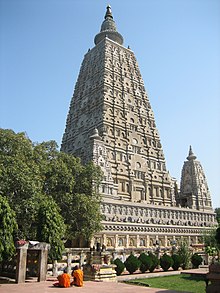

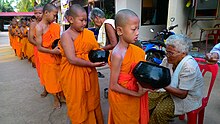


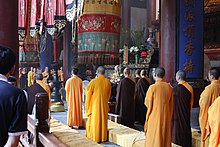


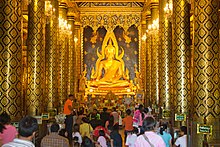


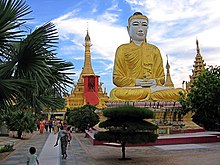



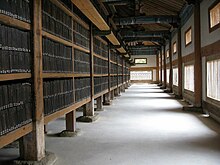
No comments:
Post a Comment